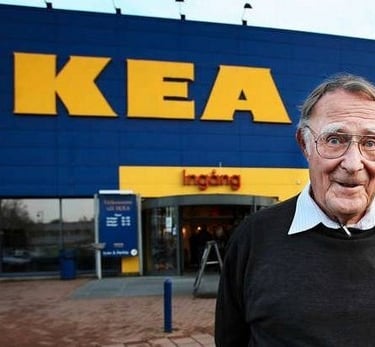Ingvar Kamprad: The Dyslexic Boy Who Built a $25 Billion IKEA Empire
Ingvar Kamprad, founder of IKEA, started selling matches at age 5 and battled dyslexia. Rejected by Sweden’s business world, he went on to build a $25 billion empire. His journey is a testament to resilience, simplicity, and innovation.
SUCCESS STORYMOTIVATION
Thrivevision
4/16/20252 min read


Behind the iconic blue and yellow IKEA storefront lies a story of grit, vision, and resilience. The man who made flat-pack furniture a global phenomenon—Ingvar Kamprad—had anything but a smooth start in life.
Born in 1926 in rural Sweden, Ingvar’s entrepreneurial spirit showed early. At just 5 years old, he began selling matches door-to-door. It wasn’t glamorous, but it was the beginning of a mindset that valued resourcefulness, frugality, and efficiency—principles that would later define IKEA.
Despite his drive, Kamprad faced serious challenges. He struggled in school due to dyslexia, a condition that made traditional learning difficult. But what others saw as a weakness, he turned into an advantage. Dyslexia pushed Kamprad to simplify and organize everything, a skill that later helped shape IKEA’s famously minimalist product design and instruction manuals.
He was also rejected by the Swedish business elite, who didn’t see the potential in his vision of affordable, well-designed furniture for the masses. But Kamprad wasn’t looking for approval. Instead of trying to fit in, he built his own path, starting IKEA in 1943 at just 17 years old.
The name IKEA came from his initials (I.K.), his family farm Elmtaryd, and his village Agunnaryd. From those humble beginnings, IKEA evolved into a retail revolution. Kamprad pioneered the flat-pack furniture model, allowing customers to transport and assemble products themselves, slashing costs and redefining the shopping experience.
But Kamprad’s genius wasn’t just in logistics. He believed deeply in democratic design—that everyone, regardless of income, deserved a beautiful home. This philosophy drove IKEA’s mission and set it apart from traditional luxury brands.
Despite becoming a billionaire, Kamprad remained famously frugal. He flew economy, drove a modest car, and furnished his home with IKEA products. To him, saving money wasn’t just personal—it was part of the company’s DNA. By keeping costs low, IKEA could keep prices low for customers.
Today, IKEA is a $25 billion empire, with hundreds of stores in dozens of countries. But its roots trace back to a little boy with matches, a struggle with dyslexia, and a belief that design should be for everyone.
Inspiration
Explore success stories and motivational journeys today.
Growth
Vision
© 2025. All rights reserved.
